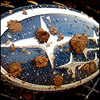Linear Synchronous Motor (LSM) Launch
#61

Posted 22 January 2006 - 11:20 AM

#62

Posted 22 January 2006 - 01:40 PM
The microswitches I got at a local electronic surplus store called Gateway Electronics. As for the iron cores, I am not sure where you guys could get them, I had cut a bunch of them in the high-school's metals lab, since the teacher let me take a whole cord of metal flat-stock.
-Tyrant
#63

Posted 22 January 2006 - 02:31 PM

#64

Posted 22 January 2006 - 03:19 PM
-Tyrant
#65

Posted 22 January 2006 - 03:38 PM

#66

Posted 22 January 2006 - 04:39 PM
Plus engineers suck at the english language.
-Tyrant
#67

Posted 22 January 2006 - 04:47 PM

#68

Posted 22 January 2006 - 05:14 PM
-Tyrant
#69

Posted 22 January 2006 - 06:27 PM

#70

Posted 23 August 2006 - 11:58 PM
*EDIT* And this thing has major potential now.
*Double EDIT* Here are some photos of the devolpment we are doing. I pretty much take video of the original pulse, then go into Adobe Premier Pro, count the number of frames it takes for the car to make it into the next section, divide that by 30fps, then multiply times 1000 to get the approximate milliseconds to plug into the program. Ron enters the numbers, as well as wrote the program on his own. We get some approx numbers, plug em in, and tweak tweak tweak.
http://img206.images...3/dev003cc9.jpg
http://img219.images...4/dev010te6.jpg
http://img208.images...4/dev007by6.jpg
http://img219.images...8/dev002xp7.jpg
-Tyrant
Mod's have to follow rules too-CC10
#71

Posted 24 August 2006 - 01:24 AM
Here is a demonstration of how the process goes. I insert numbers, watch it launch, tweak the numbers, and keep going and going till it works flawlessly. Right now it won't seem like much speed, but that is because we only have one accelerating magnet on the track as of now. The first magnet is merely a "push" magnet that doesn't act as an accelerator.
We will be adding on at least two more magnets tomorrow afternoon/night then tweaking the program even more, hopefully get some more solid numbers so that I can try and derive a formula that will allow to adjust the entire set of magnets on the fly.
Currently the first "push" magnet is on for 265 milliseconds, then a "dead-time" where nothing is turned on for 65 milliseconds, then the first accelerating magnet is set for 150-ish milliseconds (+ or - 10 milliseconds). The reason the 2nd magnet isn't a solid value is because we need to test and see if the 3rd magnet will affect the 2nd magnet and its force in any way. For example, when firing only the first magnet, I thought I had come up with a solid number of 310 milliseconds, however when factoring in the 2nd magnet, the number got dropped to 265 as the most effective.
Anyways, here is the demonstration video:
http://media.putfile...M-Demonstration
Also, always remeber the horrors of Judy Blume:
http://media.putfile...bout-Judy-Blume
Enjoy. The next couple of days should be very interesting as far as progress comes along.
-Tyrant
#72

Posted 24 August 2006 - 01:50 AM
#73

Posted 24 August 2006 - 08:42 AM
The instructions that come with it, espically on how to program it, are very vague, so I had to do alot of diging myself. Once I get a nice program written, I'd be glad to give you the source and/or the exe's.
It's nice to actually apply the yearlong C++ class I took, but I'm having trouble remembering it all. If you guys ever have the chance to take a programing class, espically C++, I suggest you take advantage of that.
Oh, and as for this step up, It amazes me what amount of control we now have over the car, and what a big difference a 15ms change can make. Looking back, it would've been impossible to even get lucky without having some sort of "PLC" like the real LIM/LSM launch coasters. Live and Learn!
University of Missouri - Rolla
Computer Engineering
#74

Posted 24 August 2006 - 12:48 PM
Although it doesn't look any easier...
Once you master it it would be nice to see an impulse coaster, becasue it's almost impossible to make a working one any other way (without using two tracks like Vertigo).

#75

Posted 24 August 2006 - 03:35 PM
-CC10
SSCoasters Staff | The SSCoasters Forum Rules
University of Illinois at Urbana Champaign | Computer Science & Mathematics
Fireball | Kingda Ka | Inclination | Diamondback
#76

Posted 24 August 2006 - 04:12 PM

^My second model^
#77

Posted 24 August 2006 - 04:40 PM
-Tyrant
#78

Posted 28 August 2006 - 01:39 AM
-Tyrant
#79

Posted 01 September 2006 - 12:22 PM
Well, I am still wrapping the cores, up to about 5 of them done by now. They each take about 45 minutes to wrap neatly and tightly. Tightly wrapped is how they need to be done, since any air-gaps will slightly reduce the magnetic field created by the wire. A few are fine, and sort of expected since its hard to get them to be perfect. Anyways, I am still in the process of designing the placement of the electromagnets and the switches, as well as creating an AutoCAD layout of where I need to drill holes for wires and clean cable management. Although I don't have any pictures of the actual launch yet, I thought I would show you pictures of the various components of the launch itself. To start you off, this is a picture of one of the compleleted electromagnets, notice how the wires are tightly wrapped, the tape on the ends is to keep the wires from jumping off and causing a mess. Also the other picture shows a magnet about half-way through completion.
Completed Electromagnet
Half-way completed Electromagnet
The other big thing that most of you seem to be getting confused on is the Magnetic Switch. I was originally going to be using switches from Radio Shack, however the price was rather steep with them being around $5.59 each. So I went down to Gateway Electronics, a surplus electronics store native to St. Louis and was able to find some older magnetic switches that were only $1.95 each, and bought 10 of them. I also bought eight 9-Volt batteries from Kmart for $18. The 9-Volt batteries are the main power supply, 4 for each group, totalling about 36-Volts going across the electromagnets at once.
Magnetic Switch
9-Volt Power source
Now moving onto the car. Right now for testing purposes, I am just using one car that has an aluminum plate mounted underneath the chassis which I custom-built from a piece of $3.95 Aluminum Duct casing. The Aluminum plate was used to hold the 3 magnets close to the electromagnets during the launch (about 0.125" above them), Aluminum was used because it doesn't not have any magnetism, thus will not interfere with the magnetic field. The 3 magnets that are mounted on the train are 1/2" round button magnets from Radio Shack, they can be bought in a pack of five for about $1.95. I mounted the magnets so only the southern pole is facing down. Mounting was rather easy, as I just used a hot-glue gun to put the magnets to the aluminum, and then to attach the aluminum plate to the car.
A view of the Aluminium mounting bracket
A close-up view of the 3 magnets mounted inside
I also managed to create an AutoCAD wiring diagram to help me in the logic of wiring up the entire launch. Some of you who may know some stuff about electrical circuts will be able to decipher the diagram. Quite simply, the labels MS# represents the Magnetic Switches, while the SOL# represents the electromagnets. The switches are mounted in a 1-2-3-4-5-6-7-8-9-10 fashion, right above the electromagnets. Take notice at the battery source. Notice the top ladder uses a source in which the current moves + to - and the lower ladder uses a source in which the current moves - to +. When the train hits one switch, it closes the circut for whichever switch it is on, and sends the current moving throughout, depending on which way the current moves, the electromagnets will have a different polarity. So if the train is currently in switch #3, the current will be flowing from + to -, so the polarity on the electromagnets will change such that it will push the train into the next switch. Power is then cut, and the next switch (#4) is activated, which reverses the current flow, reversing the polarity, and once again pushing the car into the next switch. Hopefully this diagram will clear up some confusion.
Electrical Wiring diagram
-Tyrant
Could you repost these? I'm looking at trying something like this for science fair.
#80

Posted 01 September 2006 - 02:14 PM
Currently compiling a massive list





















